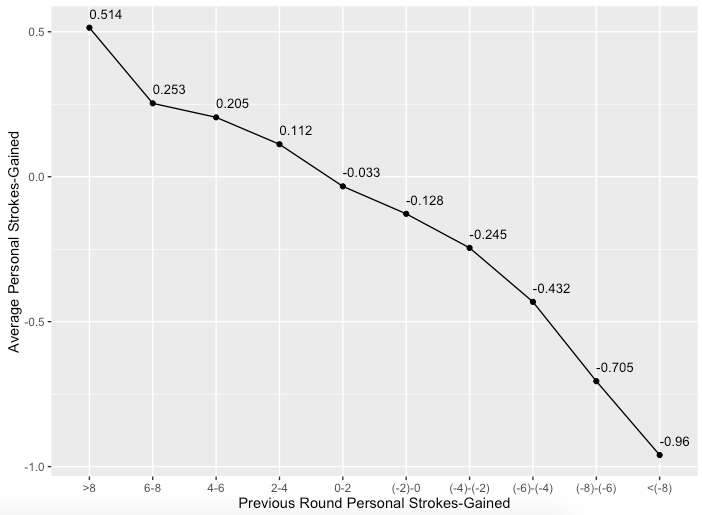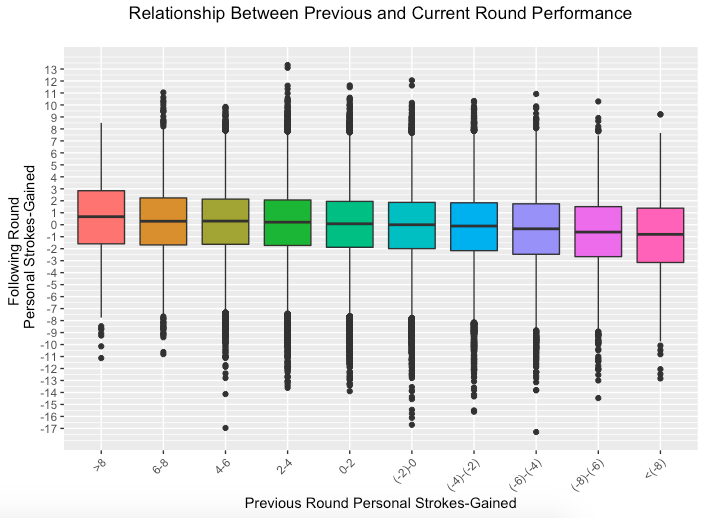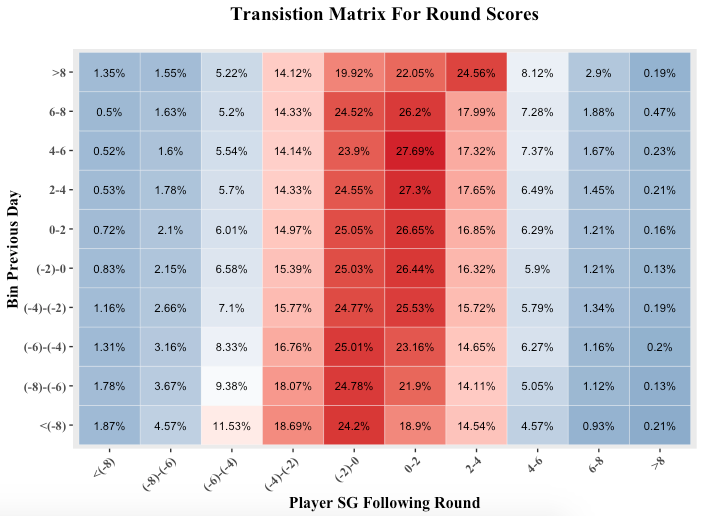Traditional wisdom in golf states that it is difficult to follow up great rounds of golf with continued good play. While this notion is intuitively appealing, it could also be a product of confirmation bias; whenever a player plays poorly following a great round, golf analysts are sure to point how difficult it is to play well after a great round (for several intuitively appealing reasons), thus confirming the theory. However, when a player follows up a great round with another great round, golf analysts likely fail to make the connection that this goes against the aforementioned theory.
Let’s see what the data has to say on this question. Using round-level data on the PGA Tour from 2000-2016, we first calculate each player’s baseline relative-to-the-field scoring average on a 3-year rolling basis. Then, for each round played we calculate the difference between a player’s relative-to-field score that day, and their baseline relative-to-field score; let’s refer to this as “personal strokes-gained”. To be clear, if Phil typically beats the field by 1 shot, and then plays a round where he beats the field score by 4 shots, his personal strokes-gained would be 3.
We want to look at the relationship between a players performance in a given round to his performance in the round that follows. We classify rounds into different “bins”; for example, one bin is defined as the set of rounds where a player had a personal strokes gained of 8 or more. The other bins are defined similarly as rounds with personal strokes gained of 6-8 shots, 4-6 shots…so on…down to -8 or worse shots. We then look at what the distribution of personal strokes gained looks like depending on which bin a player’s previous round belonged to.
To be clear, sticking with the Phil example, where we have assumed Phil typically beats the field by a shot, suppose he beats the field by 5 shots following a round where he beat the field by 4 shots. In the first of these two rounds Phil’s personal strokes gained was 3 shots, so he enters the “2-4 shots” bin, and the object of interest to us is then how Phil plays in the next round (in this case he had a personal strokes gained of 4). We do this for all players and rounds and are able to obtain “conditional distributions” of personal strokes gained, where we are conditioning on how a player played in his previous round (as defined by the bins). In lay terms, we are simply looking at the personal strokes-gained of the set of players who all fell into the same bin in their previous round, and looking to see if their are differences between these sets of players (i.e. do those who had 2-4 personal strokes gained in their previous round play better than those who had 0-2 personal strokes-gained in their previous round?).
To start, the average personal strokes-gained for each bin is shown below:

A very clean relationship emerges; given that you played well in the previous round, it is more likely, on average, you will play well in the following round. The analogous statement holds for poor play. This is not all that surprising; it simply means that form, good or bad, tends to last more than a single round. Although, there clearly is a tendency to regress to the mean at work here as well.
The next figure gives a better sense of the entire distribution of personal strokes-gained conditional on playing at a certain level in the previous round:

The horizontal bar in each box is the median of the data, the upper and lower bounds of each box is the 75th percentile and 25th percentile respectively, and the ends of the lines are the maximum and minimum values excluding outliers (where an outlier is defined as 1.5*the 75th percentile, and 1.5* the 25th percentile). Note that the most extreme rounds are contained in the middle bins; this is expected as these bins contain by far the largest number of rounds, and consequently there is the greatest potential for an outlier to emerge.
In this final figure we report a transition matrix, reporting the probability of moving from one bin to the next in consecutive rounds. There is a lot of interesting information here, take a long look:

To ensure you are interpreting this correctly, the top left box states the following: given a player’s personal strokes gained was 8 or better in their previous round, there is a 1.35% chance that their personal strokes-gained is negative 8 or worse in the next round.
It is surprising to us how well-defined the relationship is between a player’s performance in one round to the next. For example, consider the column for bin (2-4); as you move from the bottom row to the top row we are looking at the set of players who played increasingly better in their previous round, and the probability of entering the (2-4) bin is increasing monotonically, just as expected.
Finally, to answer the initial question: there is no evidence supporting the claim that it is more difficult to follow up a great round with a good or mediocre one. A big reason this claim makes sense intuitively is that it is simply very unlikely to shoot a really good round (of 6 or more strokes better than usual, suppose). Therefore, it is unlikely that an exceptional round will be followed by another exceptional round; but that is always the case irrespective of a player’s performance in the previous round.
